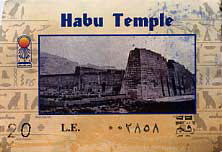The Trip To Egypt, 2004
Egypt Home Day 1, Egyptian Museum, Cairo Day 2, Pyramids and Sphinx At Giza Day 3, Dahshur (Bent and Red Pyramid), Day 3a, Sakkara (Stepped Pyramid) Day 4, Abu Simbel Day 4a, Aswan Day 5, Philae Temple Day 5a, Kom Ombo Temple Day 6, Edfu Temple Day 6a, Esna Temple Day 7, Luxor, Medinet Habu, Village of Deir El Medina Day 7a,Temple of Hatshepsut Day 8, Valley of the Kings Day 8a, Valley of the Queens, Luxor Museum Day 9, Luxor, Tut's Tomb Day 9a, Temples of Karnak and Luxor Day 10/11, Cairo, Museum, Manial Palace, Churches and Mosque
Day 6, Luxor, Medinet Habu,
Village of Deir El Medina

Luxor 11/5 Friday
West bank a.m.
East bank p.m.
West bank again tomorrow
Then east bank again.
Home of the Pharaohs; greatest art period.
86% of Egypt is desert.
3 biggest crops are cotton, sugar cane & rice.
Same food as ancient Egypt. Cottage cheese + salt =mish; Fasich
(sp?) Nile perch salted & stored in metal container. Takes
a strong stomach to eat this stuff.
No laundromats. Showing dirty lingerie to anyone else is a big no-no. No dryer needed; so dry everything air dries quickly.
Colossi of Amenhotep III (temple) ruined in flood.
Village of Gorna=descendants of ancient Egypt. Their ancient ancestors were probably tomb-robbers said Aki, since they helped make the tombs & knew how to get in & out & what was there.
1183 BC Ramses III
(11 Ramses in total)
Medina Tabu
Dedicated to Amun Ra
Gate=duplicate of Syrian Hittite fortress he won. Buildings were
usually never more than 2 floors. So this is the equivalent of
a skyscraper since it was bigger. Leaning walls to keep sand
from building up. Bonus for soldiers was a present for killing
the enemy. Prove you killed him by bringing hand to the king.
But some cheated and brought both hands from one dead enemy and
claimed it was 2 different enemies. So king said OK, you must
bring me something they have only one of: penis. (This is where
we saw a live wasp on the stone floor & a hieroglyphic wasp
on the wall.)
King visited 2x/year to commune w/the priests. Show approval to people. Series of doors closed out all but highest priest & the king thru the last door & into the sanctuary. Maintain the mystery this way. Not for common people.
More preserved color here than elsewhere because: drier climate; mineral not vegetable color used; deeper carving. (Photos show deepest carving)
Egypt: History
of the name
Land of milk & honey
to the Arabs. This land=Misr.
But in 640 BC higher tax if not want to be Muslim. Arabs taxed
Christians & Jews for their religion so some left & came
to village 60 miles north of Luxor called Kuft. Arabs didn't
care because this was too far away to be of interest. A Greek
visitor of the time saw Kuft and saw the Kuftese weren't Muslim.
Christians & Jews because El Kuftese which became El Egyptese
which then became Egypt. Our history is from the Greeks who called
it Egypt so we do today. Egyptians get their history from the
Arabs so they call the country Misr.
Kemet=what Ancient Egyptians called themselves=black soil.
Frog in hieroglyphics = 1,000 years. King kills wild bull = sign of power.
Temple of Ramseum=biggest
1-piece statue made here. Ramses II-only remnant is left.

The Temple gates line up.

Almost a week of this and this man can still smile!

This man was playing an instrument in from of a restaurant near the temple.